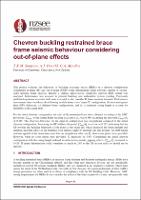| dc.description.abstract | This project evaluates the behaviour of buckling restrained braces (BRBs) in a chevron configuration considering IP and OOP frame deformations using software capable of second-order inelastic frame analysis. Initially a single-storey, single-bay chevron BRB system, representing a realistic building, was analysed. Performance was assessed to prevent buckling, as well as yielding in elements other than the encased steel core, with IP frame moment demands. Performance assessments then considered the following modifications: (a) changing to a ‘super-X’ configuration (b) increasing the gusset plate (GP) stiffnesses, (c) changing the beam stiffness, and (d) shortening the casing length to account for flexibility at the casing ends.
For the initial chevron configuration, the ratio of the maximum brace force obtained according to the AISC provisions, Cmax, to the system Euler buckling axial force, Pe, was 0.389. This exceeded the maximum allowable Cmax/Pe of 0.285. The observed difference for the super-X was insignificant. Increasing the GP stiffness decreased Cmax/Pe to as low as 0.215. Once cover plates were added, increasing the beam stiffness was insignificant for buckling. A lateral restraint OOP at the beam-brace joint had an insignificant effect on Pe unless no cover plates are provided, in which case Pe increased by 6.8%. Considering the initial chevron configuration with the casing length reduced at each end by the casing width, Cmax/Pe increased to 0.426. In critical yielding elements it was found that IP frame deformations could contribute as much as 25% to the total gusset plate yield, and therefore should not be ignored. | |

